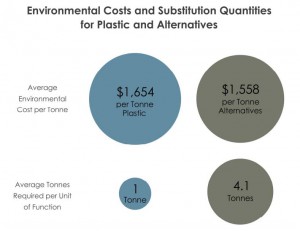A new study in the journal Science Advances looks at the “Production, Use and Fate of All Plastics Ever Made.” We welcome this new study, and the opportunity it provides to context to the important discussions around plastics’ growth and post-use management.
Let’s start with a fact that might be counter-intuitive: plastics are highly efficient materials that help us conserve resources and reduce waste. That’s right: plastics actually reduce waste.
Why is that? Because to have the benefit of the products we enjoy today without plastic we’d need to use more material—much more—to do the same job. In fact, a 2016 study by the natural capital accounting firm Trucost looked at many different materials and found that if we didn’t use plastics, per-person waste generation would be roughly four times greater than it is now.
 That study also found that replacing plastics with alternatives would increase the amount of energy and transportation fuel we use, raise greenhouse gas emissions, and result in more litter.
That study also found that replacing plastics with alternatives would increase the amount of energy and transportation fuel we use, raise greenhouse gas emissions, and result in more litter.
In total, Trucost found that using plastics instead of alternatives in today’s consumer goods and packaging reduces environmental impacts by nearly four times.
Let that sink in for a minute. It provides a lot of insight into why we use so much plastic today. Plastics are lightweight, highly efficient, cost-effective materials that do their jobs and do them well. A small amount of plastic packaging for fresh fruits and vegetables extends shelf life, and reduces both food waste and the land and water resources used to grow the food. For example, just 1.5 grams of plastic can extend shelf life for a cucumber by up to 14 days. And smart plastic packaging for grapes can lead to a 20% reduction in in-store food waste.
The same Trucost study also identified opportunities to further strengthen plastics’ environmental benefits, such as new designs to use less material and lightweight cars so they use less energy. And we’re doing that; innovations like those are how we stay in business.
In the end, if we failing to manage plastics after we’ve used them the benefits are lost. That’s why America’s plastic makers support programs designed to dramatically increase plastics recycling and recovery, including: the Wrap Recycling Action Program, a public-private partnership to increase recycling of plastic wraps and bags at stores; Materials Recovery for the Future, which is researching how to process more flexible packaging at recycling facilities; Keep America Beautiful’s “I Want to be Recycled” campaign, which strengthens consumer awareness and motivation; and The Recycling Partnership, which works with communities to improve local recycling.
In addition, plastics makers regularly explore innovations in design, process enhancements, transportation efficiencies, and advancements in materials and how we use them—all of which can and will enhance the degree to which plastics benefit the environment.
There is clearly still work to be done to reduce consumer waste, reuse what we can, and recycle or recover the energy in the rest. But we are moving in the right direction, and it’s a challenge this industry is engaged to address.